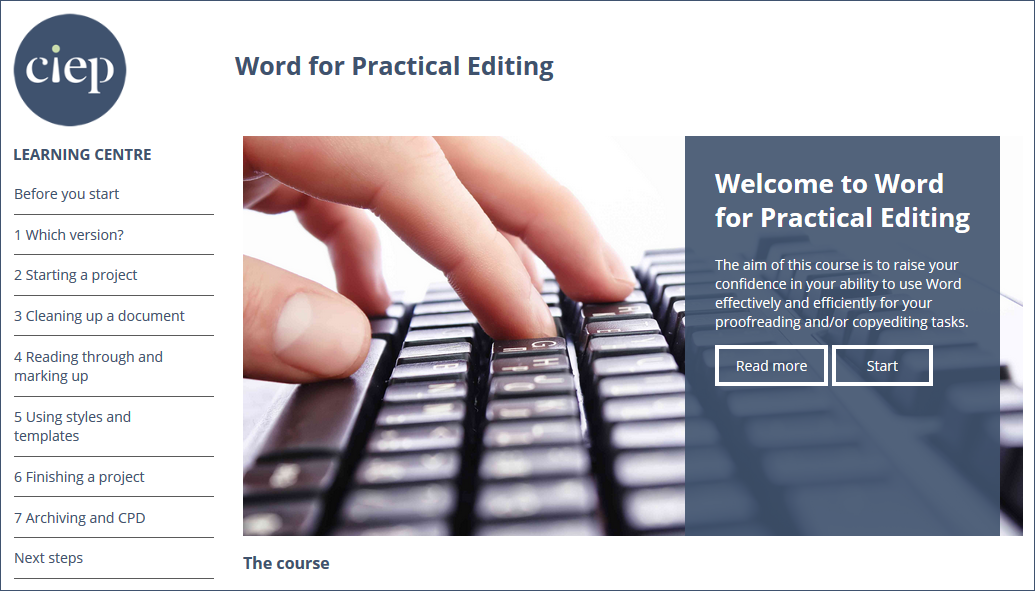 It’s a fierce world out there, particularly for freelancers, and freelance editors need to make the most of every second when their hourly income rate depends on it.
It’s a fierce world out there, particularly for freelancers, and freelance editors need to make the most of every second when their hourly income rate depends on it.
Although ‘other software is available’, Microsoft’s Word is still the go-to writing program across the English-speaking world. Therefore, maximum familiarity and minimum ineptitude have got to be good things – and those are on offer through the CIEP’s Word for Practical Editing course.
I’ve been using Word since expensive new IBM PCs were gingerly invested in by my then-employers. There was no money for training and an infant worldwide web, so when you had a query it was a case of wading through cumbersome, incomprehensible manuals or picking the brains of those who’d been using it for longer. So, over the years I’ve gradually absorbed and researched ways and means of improving my knowledge and use of this ever-updating, universal software – but it’s amazing what you fail to pick up on if you jog along on your old familiar track.
You can tell the course has been written by practising editors because it acknowledges the numerous approaches to editing tasks. Therefore you don’t feel that there is only one way to use the program or to find and use the tools. The course uses screencasts as well as documentation, so you can absorb the information in the way that suits your brain best. And when you’ve finished you end up with the study notes, exercises, model answers and a range of useful resource downloads to refer back to.
What Word for Practical Editing is not is a beginner’s guide to using Word. You do have to be a user, and you do have to know your way around the basic conventions and tools, or you’ll find yourself floundering in a sea of unfamiliar terms.
What Word for Practical Editing does do, which may be unexpected, is widen your knowledge of working in the editing world in a business-like manner and of dealing with clients.
 Whether you use a PC or a Mac, this course is for you if you want to:
Whether you use a PC or a Mac, this course is for you if you want to:
- extend your knowledge on approaching a project, beginning with the client brief before you approach the Word manuscript and tips on setting up the program and its tools, and different ways of viewing it
- improve your ability to find errors and inconsistencies – not only are you told how to use the inbuilt Find & Replace (F&R), Spelling & Grammar and Macro tools and are referred to some great add-in programs, but you are also given a useful list of common errors any editor needs to be sure they are clearing up
- clearly communicate your findings with your client – from checking the compatibility of your Word versions, to being sure that what you receive matches the brief, to different ways of showing Track Changes; you are also given useful templates for a stylesheet, an invoice and a feedback form
- check that you are using styles and templates as effectively as possible – there are several layers to using these universal bugbears, and if every Word user were sent a copy of this information the air might be less blue
- widen your knowledge of shortcuts – and you can download a useful list of them to keep referring to until they become second nature
- gain insights on archiving and CPD, because jobs aren’t always done with once you’ve sent off the edited Word doc.
I will probably not end up using all the shortcuts the course introduced me to, even though they save on keyboard time and could even ward off RSI, but I’ve certainly expanded my knowledge of what Word offers and tightened up my use of it – and therefore increased my hourly income.
What more could you want?
 Alison Shakspeare came to editing after a career in arts marketing and research for leading national and regional organisations. Her client base has expanded as her skillset has grown from basic copyediting to offering design and layout services. She truly enjoys the CPD she gains from working with academics, business organisations and a growing number of self-publishing authors.
Alison Shakspeare came to editing after a career in arts marketing and research for leading national and regional organisations. Her client base has expanded as her skillset has grown from basic copyediting to offering design and layout services. She truly enjoys the CPD she gains from working with academics, business organisations and a growing number of self-publishing authors.
Photo credit: Love to learn by Tim Mossholder on Unsplash
Posted by Abi Saffrey, CIEP blog coordinator.
The views expressed here do not necessarily reflect those of the CIEP.
